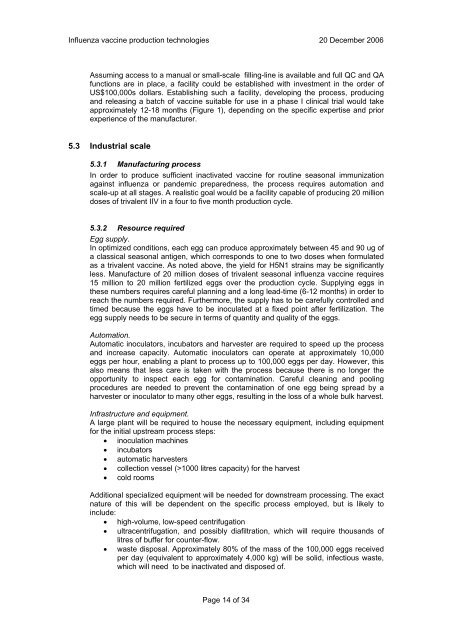A review of production technologies for ... - World Health Organization
A review of production technologies for ... - World Health Organization
A review of production technologies for ... - World Health Organization
You also want an ePaper? Increase the reach of your titles
YUMPU automatically turns print PDFs into web optimized ePapers that Google loves.
Influenza vaccine <strong>production</strong> <strong>technologies</strong> 20 December 2006<br />
Assuming access to a manual or small-scale filling-line is available and full QC and QA<br />
functions are in place, a facility could be established with investment in the order <strong>of</strong><br />
US$100,000s dollars. Establishing such a facility, developing the process, producing<br />
and releasing a batch <strong>of</strong> vaccine suitable <strong>for</strong> use in a phase I clinical trial would take<br />
approximately 12-18 months (Figure 1), depending on the specific expertise and prior<br />
experience <strong>of</strong> the manufacturer.<br />
5.3 Industrial scale<br />
5.3.1 Manufacturing process<br />
In order to produce sufficient inactivated vaccine <strong>for</strong> routine seasonal immunization<br />
against influenza or pandemic preparedness, the process requires automation and<br />
scale-up at all stages. A realistic goal would be a facility capable <strong>of</strong> producing 20 million<br />
doses <strong>of</strong> trivalent IIV in a four to five month <strong>production</strong> cycle.<br />
5.3.2 Resource required<br />
Egg supply.<br />
In optimized conditions, each egg can produce approximately between 45 and 90 ug <strong>of</strong><br />
a classical seasonal antigen, which corresponds to one to two doses when <strong>for</strong>mulated<br />
as a trivalent vaccine. As noted above, the yield <strong>for</strong> H5N1 strains may be significantly<br />
less. Manufacture <strong>of</strong> 20 million doses <strong>of</strong> trivalent seasonal influenza vaccine requires<br />
15 million to 20 million fertilized eggs over the <strong>production</strong> cycle. Supplying eggs in<br />
these numbers requires careful planning and a long lead-time (6-12 months) in order to<br />
reach the numbers required. Furthermore, the supply has to be carefully controlled and<br />
timed because the eggs have to be inoculated at a fixed point after fertilization. The<br />
egg supply needs to be secure in terms <strong>of</strong> quantity and quality <strong>of</strong> the eggs.<br />
Automation.<br />
Automatic inoculators, incubators and harvester are required to speed up the process<br />
and increase capacity. Automatic inoculators can operate at approximately 10,000<br />
eggs per hour, enabling a plant to process up to 100,000 eggs per day. However, this<br />
also means that less care is taken with the process because there is no longer the<br />
opportunity to inspect each egg <strong>for</strong> contamination. Careful cleaning and pooling<br />
procedures are needed to prevent the contamination <strong>of</strong> one egg being spread by a<br />
harvester or inoculator to many other eggs, resulting in the loss <strong>of</strong> a whole bulk harvest.<br />
Infrastructure and equipment.<br />
A large plant will be required to house the necessary equipment, including equipment<br />
<strong>for</strong> the initial upstream process steps:<br />
• inoculation machines<br />
• incubators<br />
• automatic harvesters<br />
• collection vessel (>1000 litres capacity) <strong>for</strong> the harvest<br />
• cold rooms<br />
Additional specialized equipment will be needed <strong>for</strong> downstream processing. The exact<br />
nature <strong>of</strong> this will be dependent on the specific process employed, but is likely to<br />
include:<br />
• high-volume, low-speed centrifugation<br />
• ultracentrifugation, and possibly diafiltration, which will require thousands <strong>of</strong><br />
litres <strong>of</strong> buffer <strong>for</strong> counter-flow.<br />
• waste disposal. Approximately 80% <strong>of</strong> the mass <strong>of</strong> the 100,000 eggs received<br />
per day (equivalent to approximately 4,000 kg) will be solid, infectious waste,<br />
which will need to be inactivated and disposed <strong>of</strong>.<br />
Page 14 <strong>of</strong> 34

















